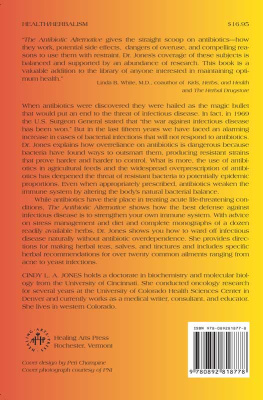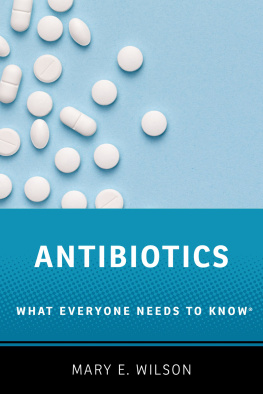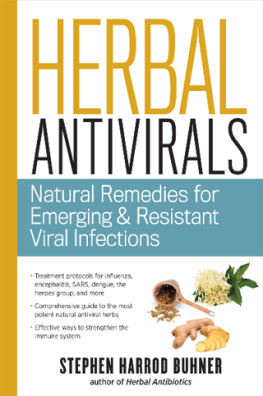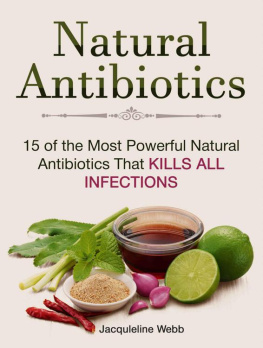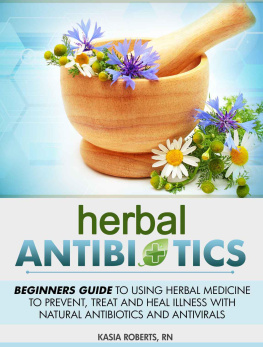The
ANTIBIOTIC
ALTERNATIVE
The Natural Guide to
Fighting Infection and Maintaining
a Healthy Immune System
Cindy L. A. Jones, PH.D.

WHAT ARE PATHOGENS?
Pathogens, which we sometimes call germs, are actually a variety of microoganisms that are at the root of disease. The word microbes refers to tiny organisms that cannot be seen without the aid of a microscope. The first of them were seen by the Dutch naturalist Antonie van Leeuwenhoek in 1675. Antonie van Leeuwenhoek was an amateur microscope builder who saw a previously unseen world when he looked through a microscope at a droplet of water. In this drop of water he viewed a world of tiny living things that he called wee animalcules, for tiny animals. We now call these tiny living things microorganisms, or microbes for short. These life-forms are 12 micrometers in size, fifty times smaller than anything the unaided human eye can see.
These microoganisms can belong to any of the five kingdoms of living things: Monera, Protista, and Fungi as well as the more familiar Plant and Animal kingdoms. Living things in these categories are subdivided down to the genus and species level in a method of naming things that was outlined in the eighteenth century by the Swedish botanist Carolus Linnaeus. It was a shorthand designation for the cumbersome naming system that was in vogue at the time. Just as all plants are denoted using this so-called binomial system of genus name followed by species name, so too are microorganisms.
Microbes can be either beneficial or detrimental to humans, depending on their food source. Microbes are a necessary part of the food web in their role as decomposers, recycling organic matter. Other microbes live in the intestines of human beings and animals to aid digestion and nutrient absorption.
WHERE DID THOSE PESKY BACTERIA COME FROM?
Chances are that bacteria were the first form of life on earth, even older than humans, even older than the dinosaurs. Early life on planet Earth probably arose from simple chemicals plus energy, a process referred to as chemical evolution. The Russian biochemist A. I. Oparin suggested this hypothesis as early as 1922, but it was not tested until the 1950s, when Stanley Miller combined the simple chemicals of hydrogen gas, ammonia, methane, and water vapor with energy in the form of heat and electricity. From these simple conditions that may have mimicked early times on Earth, organic compounds, including amino acids and nucleic acids, were formed. In a sense, in Earths early history, lakes may have served as an organic soup for dissolving the chemicals necessary for the evolution of chemicals into life.
From these small organic building blocks, it is conceivable that aggregates formed and reacted with each other, building more-complex molecules. For instance, the nucleic acids combined to form DNA, amino acids reacted to form proteins, and sugars reacted to form carbohydrates. Small droplets of these molecules could have been bound together in some way to make a cell-like structure that evolved further to create the first living thing, a bacterium. In another two billion years, these bacteria could have evolved into the more-complex cells (eukaryotic cells) that make up more-complex organisms.
These single-celled organisms belong to the kingdom Prokaryote, also referred to as Monera. Bacteria are divided into gram-positive and gram-negative groups, based on whether they can be stained with a violet-colored dye. This ability is due to differences in the architecture of the cell wall and is important in terms of the action of antibiotics. The cell wall is a rigid structure surrounding the cell membrane, giving the bacteria its shape. Bacteria are also identified by their shapesround or cocci, rod or bacilli, and spiral or spirilla.
Bacteria are adaptable to their environment. One reason is that they grow very quickly, sometimes dividing once every thirty minutes, making one become two. At this rate, in one hour there would be two bacteria, and, more dramatically, in just ten hours there would be 1,048,576 of these organisms. This high rate of reproduction makes bacteria more prone to genetic mutations. Thus, pressure from their surroundings may allow new forms of the bacteria to grow that are better adapted to the environment. This is how antibiotic resistance occurs. Although different kinds of bacteria can survive extremes of temperature, most common bacteria can be killed by heat. This is why many foods are cooked and one way that we sterilize things. Bacterial growth can also be slowed by cold, which is the reason we refrigerate food.
FUNGI
Fungi differ from bacteria in that they are eukaryotic, a more complex cell type with a visible nucleus. Most fungi consist of more than one cell and have hyphae (the threadlike filaments that make up the mycelium of a fungus) rather than roots, as plants do. Mushrooms are the reproductive part of some types of fungi that reproduce by forming spores. These spores can withstand extremes in the environment, such as heat, cold, and drying. This is one reason that fungal infections can be so persistent. The initial disease will go away, but at a later time the spores germinate and cause the infection to recur. There are also single-celled fungi, like the yeasts, that divide in a manner similar to that of bacteria.
VIRUSES
Viruses are of a different sort, not even considered a living organism by most scientists. They are not cells but are more like a particle that contains a piece of either DNA or RNA. This core is surrounded by a coat, usually made of protein. Alone, viruses are inert and require a host cell even to reproduce. Once a virus attaches to and enters a cell, it can control the proteins made by the cell. By forcing the cell to make proteins necessary for viral reproduction, the virus replicates to very high numbers until the cell bursts open, releasing millions of viral particles. Treatments for viral diseases are aimed at blocking the ability of the virus to make new DNA or RNA once inside the host cell. Examples of viral diseases are colds, flu, measles, mumps, and some types of meningitis.
Because viruses cannot be seen by normal light microscopes, they were identified much later than bacteria were. In fact, noting that infectious agents could pass through a filter that would hold back bacteria led scientists to suspect that an even smaller pathogen existed. In 1898 foot-and-mouth disease was the first disease identified as being caused by an infectious agent smaller than a bacterium, but it wasnt until the electron microscope came into use in the 1930s that viruses were actually identified and seen. Before this time, they were considered to be fluid rather than particulate. Although there are many identified viruses today, there is no classification system for them such as the one used for bacteria and fungi.
Most human beings have inactive, or latent, viruses in the body. These viruses remain harmless until an opportunity arises to cause infectionfor instance, when the human body is compromised in some way, when the immune system is not on its toes, when stress is acting on the body. Viruses can also cause some types of cancer. Liver cancer, cervical cancer, and some leukemias are caused by viruses. These specific viruses interact with the human cellular DNA in a way that creates new proteins. In this case, the new proteins do not act just for the viruses survival, but cause uncontrolled growth in the human cell as well. This uncontrolled growth is cancer. There may also be other ways in which viruses affect our bodies that we are not aware of yet.
Next page
